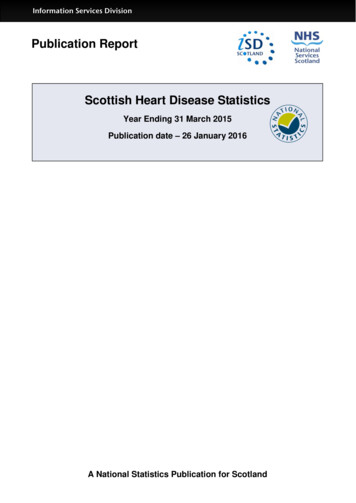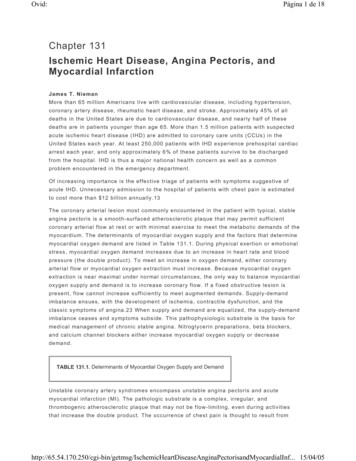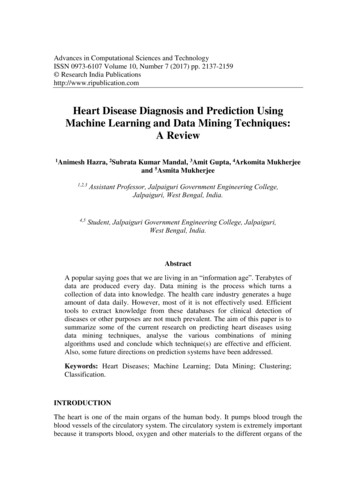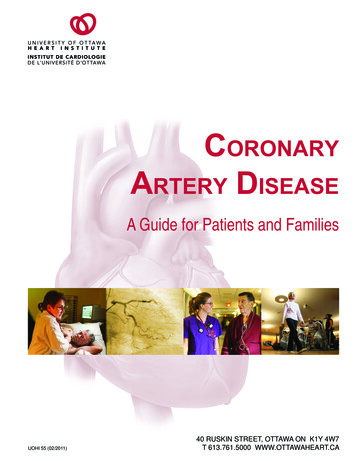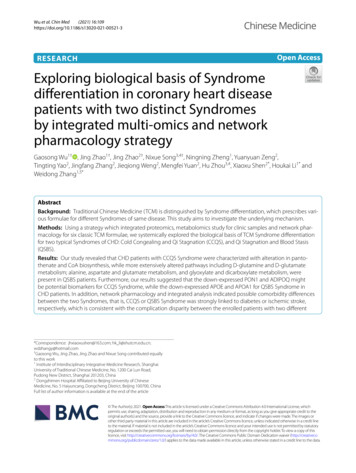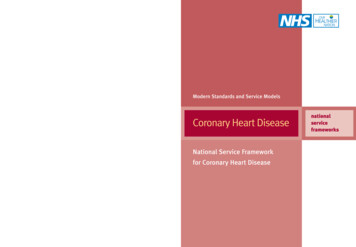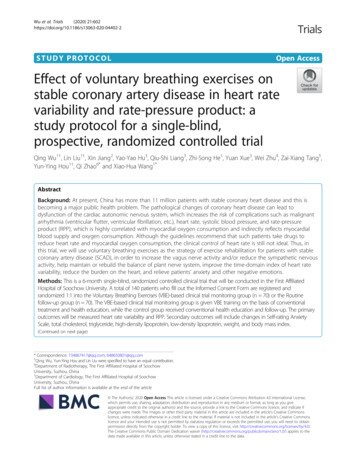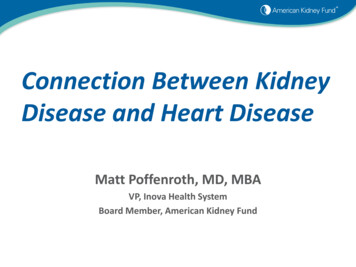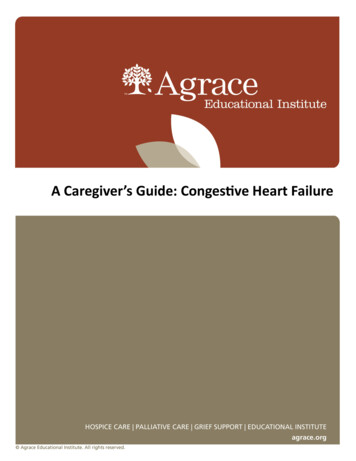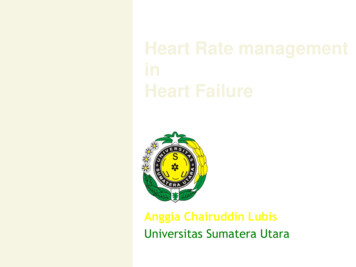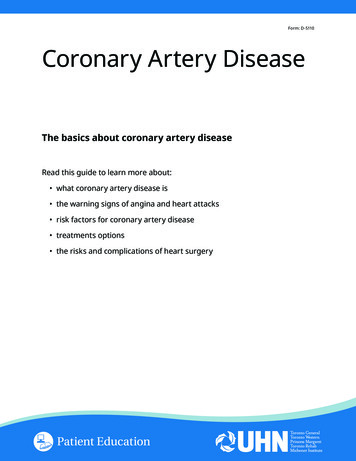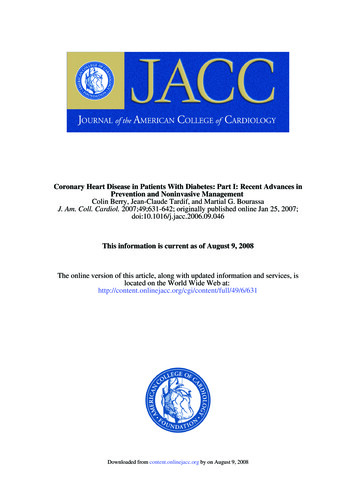
Transcription
Coronary Heart Disease in Patients With Diabetes: Part I: Recent Advances inPrevention and Noninvasive ManagementColin Berry, Jean-Claude Tardif, and Martial G. BourassaJ. Am. Coll. Cardiol. 2007;49;631-642; originally published online Jan 25, 2007;doi:10.1016/j.jacc.2006.09.046This information is current as of August 9, 2008The online version of this article, along with updated information and services, islocated on the World Wide Web 49/6/631Downloaded from content.onlinejacc.org by on August 9, 2008
Journal of the American College of Cardiology 2007 by the American College of Cardiology FoundationPublished by Elsevier Inc.Vol. 49, No. 6, 2007ISSN 0735-1097/07/ T PAPERSCoronary Heart Disease in Patients With DiabetesPart I: Recent Advances in Prevention and Noninvasive ManagementColin Berry, MD, PHD, Jean-Claude Tardif, MD, FACC, Martial G. Bourassa, MD, FACCMontreal, Quebec, CanadaDiabetes mellitus (DM) is a worldwide epidemic. Its prevalence is rapidly increasing in both developing anddeveloped countries. Coronary heart disease (CHD) is highly prevalent and is the major cause of morbidityand mortality in diabetic patients. The purpose of this review is to assess the clinical impact of recent advances in the epidemiology, prevention, and management of CHD in diabetic patients. A systematic reviewof publications in this area, referenced in MEDLINE in the past 5 years (2000 to 2005), was undertaken.Patients with CHD and prediabetic states should undergo lifestyle modifications aimed at preventing DM.Pharmacological prevention of DM is also promising but requires further study. In patients with CHD andDM, routine use of aspirin and an angiotensin-converting enzyme inhibitor (ACE-I)—unless contraindicatedor not tolerated—and strict glycemic, blood pressure, and lipid control are strongly recommended. The targets for secondary prevention in these patients are relatively well defined, but the strategies to achievethem vary and must be individualized. Intense insulin therapy might be needed for glycemic control, andhigh-dose statin therapy might be needed for lipid control. For blood pressure control, ACE-Is and angiotensin receptor blockers are considered as first-line therapy. Noncompliance, particularly with lifestyle measures, and underprescription of evidence-based therapies remain important unsolved problems.(J Am Coll Cardiol 2007;49:631–42) 2007 by the American College of Cardiology FoundationThe population health burden of diabetes mellitus (DM)and diabetic coronary heart disease (CHD) remains considerable. Our group previously reviewed the published reportsin this area (1); therefore, this work is restricted to publications from the years 2000 to 2005. We undertook asystematic Medline review with the keywords: diabetes,coronary heart disease, epidemiology, clinical trial, morbidity, mortality, myocardial infarction (MI), coronary angioplasty, stent, and coronary bypass surgery. In addition,contemporary guidelines from several national and international Societies were consulted (2–7). The present articleconstitutes the first installment of a 2-tier review thatdescribes the contemporary epidemiology, prevention, andmanagement of CHD in diabetic patients. Part II willdescribe the role and changing paradigm of coronary revascularization in the management of CHD in diabeticpatients.Recent Epidemiological DataChanging prevalence and incidence of DM is a major publichealth and economic problem (8). Worldwide estimates ofFrom the Department of Medicine, Montreal Heart Institute and Université deMontréal, Montreal, Quebec, Canada. Dr. Tardif is the Pfizer and CanadianInstitutes of Health Research Chair in Atherosclerosis. Dr. Berry is supported by aBritish Heart Foundation International Fellowship.Manuscript received July 11, 2006; revised manuscript received September 7, 2006,accepted September 11, 2006.its prevalence are expected to rise from 2.8% (171 millionpeople) in 2000 to 4.4% (366 million people) in 2030 (9).The prevalence of DM is growing rapidly in both developing and developed countries. The countries with the largestnumber of cases in 2030 will be China, India, and the U.S.The number of Americans with DM is projected to increase165%, from 11 million people in 2000 to 20 million peoplein 2025 (prevalence of 4.0%) (10). On the basis of anestimated linear increase in prevalence from 4.0% in 2000 to7.2% in 2050, the number of diabetic subjects in the U.S.population is projected to rise to at least 29 million people(10). Overall, the projected 18-million increase in 2050 canbe attributed to demographic changes (37%), populationgrowth (27%), and increasing prevalence rates (36%) (10).Insulin resistance often precedes the onset of DM andalready exists in the prediabetic states. Thus, abnormalglycoregulation is a spectrum where impaired fasting glucose (IFG), impaired glucose tolerance (IGT), and obesity(mainly central or abdominal obesity) are the intermediatestages. All 3 increase the risk to develop type 2 DM. Recentepidemiological data estimate the prevalence of IFG andIGT to be between 8% and 12% of the adult population(11). Almost 20% of middle-aged adults and 35% of theolder population in the U.S. have some degree of abnormalglycoregulation (12). In the year 2000, there were more than300 million obese adults worldwide, and industrializedcountries showed a prevalence of obesity of approximately20%. Currently, more than one-half of the adult populationDownloaded from content.onlinejacc.org by on August 9, 2008
632Berry et al.Diabetes and Coronary Heart Disease: Part IAbbreviationsand AcronymsACE-I ⴝ angiotensinconverting enzyme inhibitorARB ⴝ angiotensinreceptor blockerCHD ⴝ coronary heartdiseaseCVD ⴝ cardiovasculardiseaseHbA1c ⴝ hemoglobin A1cHDL-C ⴝ high-densitylipoprotein cholesterolIFG ⴝ impaired fastingglucoseIGT ⴝ impaired glucosetoleranceLDL-C ⴝ low-densitylipoprotein cholesterolin the U.S. is overweight or obese(13). The prevalence of obesity inchildren is also dramatically increasing worldwide, and thiscontributes to adulthood obesity(14). The prevalence of the metabolic syndrome is estimated tobe 10% to 60% (15). Although itoccurs mainly in adults, it is alsopresent in both childhood andadolescence. In the U.S., itreaches 50% in severely obeseyoungsters (16).MetabolicDerangementsAssociated With DMInsulin resistance. Type 2 DMis a multifactorial disease thatNCEP ATP III ⴝ Nationalcombines hereditary and enviCholesterol Educationronmental factors. Two majorProgram Adult TreatmentPanel IIImetabolic derangements characOGTT ⴝ oral glucoseterize DM: decreased insulin setolerance testcretion by the pancreatic betacells, and peripheral resistance tothe action of insulin or insulin resistance. Insulin resistanceor reduced insulin action on target tissues might not beresponsible for DM in the absence of a deficit of insulinsecretion (17). Insulin resistance results from environmentalfactors such as detrimental lifestyle habits, with progressivereduction of physical activity and energy expenditures andincreased input of dietary calories, fats, and saturated fattyacids and from genetic or congenital susceptibility to pancreatic beta cell dysfunction with an inability to compensatefor greater insulin requirements. Eighty percent of patientswith type 2 DM are either obese or overweight (18).Obesity and the metabolic syndrome are linked to hyperinsulinemia and insulin resistance and independently predictcardiovascular disease (CVD) and coronary atherosclerosis(19 –21).The metabolic syndrome is a common metabolic disorderthat is characterized by increases in waist circumference,blood pressure, and triglyceride levels combined with areduction in high-density lipoprotein cholesterol (HDL-C)levels and evidence of glucose intolerance (22). Reaveninitially proposed that insulin resistance was the mainculprit (1), but Lemieux et al. (23) recently suggested thatvisceral obesity and the hypertriglyceridemic waist phenotype were its central components. When the fatty cells oradipocytes are full, they release cytokines and adipokynesthat generate a systemic inflammatory state, damage bloodvessels, and contribute to hypertension, dyslipidemia, andinsulin resistance (24,25). Thus the metabolic syndromecan be seen as a disorder where central obesity leads tochronic systemic inflammation, systemic endothelial dys-JACC Vol. 49, No. 6, 2007February 13, 2007:631–42function, and insulin resistance, the main clinical components of the syndrome (12).Hyperglycemia. Despite their high incidence in type 2DM, CHD risk factors only partly account for the excessiverisk of CVD (1,25). Thus, there seems to be an associationbetween hyperglycemia and CVD. Epidemiological datasuggest that there is no specific threshold for glycemia inrelation with CV risk (26). However, the role of hyperglycemia per se in the excess CV risk is still controversial. TheUKPDS (United Kingdom Prospective Diabetic Study)showed a significant relationship, although weak, betweenchronic hyperglycemia and the incidence of MI (27). In theEDIC/DCCT (Epidemiology of Diabetes Interventionsand Complications/Diabetes Control and ComplicationsTrial) study, the incidence of CV complications was significantly reduced in type 1 diabetic patients receiving intensiveinsulin therapy initially (28). In the DIGAMI (DIabetesmellitus, Glucose insulin infusion in Acute MyocardialInfarction) study, intensive insulin therapy improved CVprognosis in diabetic after MI patients (1). Although theDIGAMI-2 study confirmed that the glucose level was astrong predictor of mortality in these patients, it did notsupport the fact that early and continued insulin-basedtherapy improved survival (29). The PROACTIVE(PROspective pioglitAzone Clinical Trial In macroVascularEvents) study evaluated pioglitazone versus placebo in theprevention of CV events in patients with type 2 DM and ahistory of CVD. Two types of results were obtained: asignificant 16% reduction in the composite secondary endpoint of all-cause mortality, nonfatal MI, and stroke, ascompared with placebo; and an increased risk of heartfailure (30). The role of glitazones in CV prevention,although strongly supported by experimental and clinicaldata, must be better defined. This is being evaluated inongoing clinical trials (Table 1).Dyslipidemia. Post hoc analyses of diabetic subpopulationsin lipid intervention trials before the year 2000 suggestedthat correction of lipoprotein abnormalities led to a decreasein CHD (1). More recently, additional clinical trials havereported similar results. For example, the HPS (HeartProtection Study) demonstrated that cholesterol-loweringtherapy was beneficial for people with DM even if they didnot already have a history of CHD or high cholesterolconcentrations (31). Allocation to 40 mg of simvastatindaily reduced the rate of first major CV events by aboutone-quarter in a wide range of diabetic patients. The resultsfrom this trial supported the use of statin therapy in diabeticsubjects with relatively normal plasma cholesterol concentrations (31). Several other trials have reported resultsconsistent with the HPS (32–34). More recently, theCARDS (Collaborative Atorvastatin Diabetes Study) specifically compared atorvastatin 10 mg daily with a placebo intype 2 diabetic patients without symptomatic CHD whohad relatively normal lipid concentrations (35). During amean follow-up of 3.9 years, atorvastatin reduced major CVevents by 37%. The ongoing ASPEN (Atorvastatin StudyDownloaded from content.onlinejacc.org by on August 9, 2008
Table 1Glycemic Control in Patients With Diabetes Mellitus—Published and Ongoing Randomized TrialsTrial (Ref.)PopulationPrimary End PointEnrolled(Randomized)Follow-UpPeriodPrimary End PointResultInterventionDIGAMI (1)PublishedIGI after arrival in hospital followed by multi-doseinsulin therapy for 3 monthsTreated or new DM withacute MIAll-cause mortality1,240 (620)Rx: 306Control: 3143 months1 yrControl: 15.6%Rx: 12.4% NSControl: 26.1%Rx: 18.6%p 0.03DIGAMI2 (29)Published1. 24 h IGI followed by SC insulin-basedglucose control2. 24 h IGI followed by standard glucose control3. Routine metabolic managementTreated or new DM withacute MIAll-cause mortality1,2531. 4742. 4733. 306Median 2.1 yrs1. 23.4%2. 21.2%3. 17.9% NSDCCT/EDIC (28)PublishedIntensive Rx: ⱖ3 insulin injections or externalpump with dose adjustments; HbA1c goal 6.05%Conventional Rx: no specific glucose goalsbeyond those needed to prevent symptomsType I diabetes age13–40 yrsTime to first of: nonfatal MIor stroke, CV death,subclinical MI, angina,or coronaryrevascularization1,441 randomizedin DCCT1,394 followedin EDICMean 17 yrsRR (95% CI):42% (9%–63%);p 0.02PROACTIVE (30)PublishedOral pioglitazone 15–45 mg daily vs. placeboType II DM HbA1c 6.5%Time to all-cause mortality,nonfatal MI, stroke, ACS,endovascular or surgicalintervention on thecoronary or leg arteries,or above-ankleamputation5,238Active: 2,605Placebo: 2,633Mean 34.5monthsActive: 514Placebo: 572HR (95% CI):0.90 (0.80–1.02);p 0.095BARI 2D (47)Ongoinga) Revascularization by PCI or surgery vs.aggressive medical Rxb) Insulin sensitization vs. insulin provision(target HbA1c 7.0% for each glycemiccontrol strategy)Type II DMAngiographic CADamenable torevascularizationEvidence of ischemia ormild angina andⱖ50% stenosis ofⱖ1 coronary arteriesAge ⱖ25 yrs5-yr mortality2,368——VADT (84)OngoingInitial Rx with metformin (obese) or glimepiride(lean), followed by rosiglitazone, followed byinsulin or other oral agents to achieve goals.Compares standard (HbA1c 8.0%–9.0%) withexcellent control (HbA1c 6.0%)Goal of HbA1c separation 1.5% (expected 2%)Age ⱖ45 yrsType II DM withpoor control(HbA1c ⱖ7.5%)MI, CV mortality, stroke,new or worsening CHF,amputation from PVD,surgical coronary or PVDrevascularization, andcritical limb ischemia1,792——IRIS (85)OngoingPioglitazone or placeboDM age ⱖ45 yrsHistory of non-embolicischemic strokeElevated FBG (insulinresistant)Time to stroke or MI3,136 expected——PPAR study (86)OngoingPioglitazone or:1) instruct weight reduction, appropriate diet,regular exercise and/or2) prescribe sulfonylurea agentsAge ⱖ45 yrsDM (HbA1c 6.5%)History of MI1. CV mortality2. CV hospitalization3,000 expected——633ACS acute coronary syndrome; CAD coronary artery disease; CHD coronary heart disease; CHF congestive heart failure; CI confidence interval; CV cardiovascular; DM diabetes mellitus; FBG fasting blood glucose; Hb hemoglobin; HR hazard ratio;IGI insulin-glucose intravenous infusion; MI myocardial infarction; NS not significant; PCI percutaneous coronary intervention; PPAR peroxisome proliferator-activated receptor; PVD peripheral vascular disease; RR risk reduction; Rx treatment; SC subcutaneous.Berry et al.Diabetes and Coronary Heart Disease: Part IDownloaded from content.onlinejacc.org by on August 9, 2008StatusJACC Vol. 49, No. 6, 2007February 13, 2007:631–42Glycemic Control in Patients With Diabetes Mellitus—Published and Ongoing Randomized Trials
634Berry et al.Diabetes and Coronary Heart Disease: Part Ifor the Prevention of CHD ENdpoints) also comparesatorvastatin and placebo specifically in type 2 diabeticpatients.Diabetic dyslipidemia has a characteristic lipid profilethat includes elevated plasma triglycerides, normal or mildlyelevated low-density lipoprotein cholesterol (LDL-C),and reduced plasma HDL-C concentrations (1). Although hypertriglyceridemia increases the risk of CHD inDM, the effect of statin therapy for the treatment ofhypertriglyceridemia before the DALI (Diabetes Atorvastatin Lipid Intervention) study was uncertain (1). In theDALI study, high-dose atorvastatin therapy reduced totalcholesterol, LDL-C, and apoB to a greater extent thanlow-dose atorvastatin. Plasma triglycerides decreased andHDL-C increased to a similar extent in both groups (36). Inthe DAIS (Diabetes Atherosclerosis Intervention Study),treatment with fenofibrate reduced angiographic progression of CHD in patients with type 2 DM, good glycemiccontrol, and mild lipoprotein abnormalities (37). However,in the FIELD (Fenofibrate Intervention and Event Lowering in Diabetes) trial, although fenofibrate reduced plasmatriglycerides and increased HDL-C concentrations, it didnot significantly decrease the incidence of CV events (38).Thus, regardless of the lipid profile, current evidence doesnot warrant replacing statins as the first choice for prevention of CHD in patients with DM. The potential role offenofibrate as part of combination therapy is the focus of theongoing ACCORD (Action to Control CardiOvascularRisk in Diabetes) trial.Particularities of CHD in DMIn a population-based autopsy study, coronary arteries wereexamined at 5-mm intervals with a semiquantitive gradingsystem (39). High-grade atherosclerosis was defined asgrade 3 (50% to 75%) left main stem disease or grade 4( 75%) disease for other arteries. Coronary atherosclerosiswas found in 49% of diabetic and 33% of nondiabeticdecedents. Diabetic decedents more often had MI byautopsy, ventricular dilation, high-grade atherosclerosis, andmultivessel disease. The global atherosclerotic burden andprevalence of multivessel disease were similar in diabeticpatients without a history of CHD and in non-diabeticpatients with a history of CHD. These findings revealed ahigh prevalence of subclinical atherosclerosis in diabeticsubjects without a clinical history of CHD. Ledru et al. (40)recently compared coronary disease in consecutive diabeticand non-diabetic angiography referrals. Coronary disease,objectively evaluated with 3 severity score systems, was moresevere in diabetic than in non-diabetic patients and includedhigher coronary occlusion rates. However, age, gender,LDL-C concentration, and hypertension were more powerful predictors of disease severity than DM. Recent casecontrol studies have found that, compared with nondiabetic patients, diabetic subjects typically have more severecoronary disease, more extensive coronary calcifications, aJACC Vol. 49, No. 6, 2007February 13, 2007:631–42higher prevalence of left main stem disease, and reducedcoronary collateral artery recruitment (41– 43).Accelerated atherosclerosis and thrombosis in patientswith DM are mainly due to systemic inflammation, oxidative stress, and systemic endothelial dysfunction (25,44,45)combined with coagulation and platelet function abnormalities (25,46,47) and impaired fibrinolysis (47).Epidemiology of CHD in DMThe prevalence of CHD rises from 2% to 4% in the generalpopulation to as high as 55% among adult diabetic patients(1). Diabetes mellitus is an independent risk factor for CVDin both men and women. Excess risk for CVD can be foundin patients with type 1 and type 2 DM, in patients in theprediabetic stages, and in patients with obesity and with themetabolic syndrome (26).Mortality in diabetic patients. The overall mortality fromheart disease is twice as great in men and is 4 to 5 timeshigher in women with than without DM (1). Cardiovascular disease represents over one-half of all deaths in both type1 and type 2 DM (48). In addition, non-CV mortality isgreater in diabetic compared with non-diabetic subjects, andthis excess risk remains constant during long-termfollow-up (49,50). Diabetes mellitus has been considered asa CHD risk factor equivalent. In a prospective cohort study,the age-adjusted relative risk of death from any cause was2.3 among men with DM but without CHD, 2.2 amongmen with CHD and without DM, and 4.7 among men withboth DM and CHD (51). Patients with DM are more likelyto die after an MI than patients without DM (26,52).Morbidity in diabetic patients. Diabetes is associated withan increased risk of morbidity in patients with CHD (51).Diabetes mellitus and obesity are predictors of MI (52).About one-quarter of patients who present with an acuteMI have DM (12). Diabetes mellitus is a predictor ofischemic stroke and heart failure, and diabetes increases theoverall CV risk in patients with heart failure (53,54).Diabetic patients undergo invasive management less often,and when referred for coronary angiography, they waitlonger (55,56). In addition, quality of life is reduced in DMpatients compared with nondiabetic patients (57).Mechanisms for the excess CV risk attributable to DM.The mechanisms responsible for the increased CV mortalityand morbidity attributable to DM are multifactorial. Inaddition to a high prevalence of conventional risk factors,important contributing mechanisms include insulin resistance and hyperinsulinemia, hyperglycemia, subclinical atherosclerosis, congestive heart failure, acute coronary syndromes, and end-stage renal failure (12). The first 3 itemshave been previously discussed. Increased mortality in diabetic patients with left ventricular dysfunction and heartfailure can be attributed to CHD, hypertension, left ventricular hypertrophy, obesity, autonomic dysfunction, anddiabetic cardiomyopathy (12,58). Diabetes is a major riskfactor for adverse outcomes in patients who suffer fromDownloaded from content.onlinejacc.org by on August 9, 2008
Berry et al.Diabetes and Coronary Heart Disease: Part IJACC Vol. 49, No. 6, 2007February 13, 2007:631–42unstable angina or MI (12,26). Autonomic dysfunctionlowers the threshold for life-threatening arrhythmias andincreases the risk of hemodynamic instability. Coagulationand platelet abnormalities increase the risk of thrombosis atthe site of plaque disruption and possibly increase the risk ofreinfarction after thrombolytic therapy. Finally, diabetes hasemerged as the leading cause of end-stage renal disease inthe U.S., and this condition carries a 5-year survival of only20% in patients with DM and CHD (12,59). Albuminuriais an important prognostic marker and a potential target fortherapy in hypertensive diabetic patients with impairedrenal function (60). Recent clinical trials have shown thatboth angiotensin-converting enzyme inhibitors (ACE-Is)and angiotensin receptor blockers (ARBs) are nephroprotective in patients suffering from type 2 DM, and theseeffects are independent from those attributable to bloodpressure (BP) lowering (61– 64).Primary Prevention of DM in At-Risk IndividualsScreening. The American Diabetes Association recommends screening for type 2 DM in at-risk individuals (4). Inparticular, individuals ages 45 years or older who have aBMI ⱖ25 kg/m2 should be assessed at 3 yearly intervals.The screening test should include a fasting blood glucose(FBG) or a 2-h oral glucose tolerance test (OGTT) (4). Adiagnosis of DM is made if 2 consecutive FG levels areⱖ7.0 mmol/l (126 mg/dl) or a 2-h post-load value is ⱖ11.1mmol/l (200 mg/dl) within a 3-month period. In addition,community screening programs should be targeted to at-riskindividuals (65).Lifestyle modification. The hypothesis that type 2 DM ispreventable is supported by recent clinical trials. At least 2types of interventions have demonstrated their efficacy interms of primary prevention of type 2 DM: lifestyle modification by dietary measures and physical exercise aiming atweight loss, and different pharmacological interventions.Lifestyle modification, in patients with prediabetic states,has been shown in 3 placebo-controlled trials to markedlyreduce the risk of new-onset DM (66 – 68) (Table 2).Nutritional therapy coordinated by dieticians had an important role in the lifestyle intervention, and individualizedtherapy is currently recommended in type 2 DM (4). Alongwith 1 earlier controlled trial of lifestyle changes for theprevention of DM in at-risk patients in China (68), theDPP (Diabetes Prevention Program) and Finnish trialssupport a strong recommendation for lifestyle interventionin patients with IGT (Table 2).Pharmacological interventions. Recent trials in patientswith hypertension and heart failure have indirectly shownthe preventive effect of ACE-Is on DM (69 –72). Similarresults were reported with ARBs (73–76). These data mustbe interpreted with caution, however, because prevention ofDM was not the primary end point in any of these trials.The effect of ACE-Is and ARBs on the progression to DM635is now being tested as a primary outcome in ongoingrandomized trials (77,78) (Table 2).Other drugs that have also been shown to reduce the newonset of DM in at-risk subjects (obese or prediabeticindividuals) include acarbose (79), bezafibrate (80), andperoxisome proliferator-activated receptor (PPAR) gammainhibitors (81). In the DPP, the crude incidence of DM was11 cases/100 person-years, 7.8 cases/100 person-years, and4.8 cases/100 person-years for the placebo, metformin, andlifestyle-intervention groups, respectively (66). Comparedwith placebo, these interventions were also associated withincreased time to DM onset, reduced glycosylated hemoglobin (HbA1c), and reduced FG concentrations. Overall,metformin was less effective than lifestyle intervention (Fig. 1,Table 2).Secondary Prevention andManagement of CHD in Diabetic PatientsScreening for CHD in diabetic patients. Diabetes iscommonly considered as a CHD risk equivalent (2,6).High-risk diabetic patients include those with typical oratypical symptoms, those 55 years or older, those withperipheral or carotid vascular disease, and those with 2 ormore of the following risk factors: hyperlipidemia, hypertension, smoking, family history of premature CHD,microalbuminuria, and progressive retinopathy (82).Screening for CHD might be indicated in younger individuals, with a relatively short duration of DM and few risk ordiabetic complications, because most guidelines recommendmore aggressive management of risk factors in the presenceof CHD. Detection of CHD involves the usual diagnosticmethods, which include exercise stress testing and, asindicated, myocardial perfusion scintigraphy or stressechocardiography (82).Pharmacological interventions to prevent CHD in diabetes.The implementation of lifestyle modification, includingdietary measures and aerobic exercise aiming at long-termweight loss, are even more critical in patients with diabeticCHD than in those with DM alone, because of the higherrisk of CV events in these patients.ANTIPLATELET THERAPY. Primary prevention therapy withaspirin is recommended in diabetic patients 40 years ofage, with additional risk factors, and/or with diabetes 10years’ duration (4). Contemporary guidelines recommendprophylactic therapy with aspirin for diabetic patients withCHD (4,46). In patients who do not tolerate or have acontra-indication to aspirin, clopidogrel can be used as analternative antiplatelet agent.A post hoc analysis of the diabetic patients randomized inthe CAPRIE (Clopidogrel versus Aspirin in Patients atRisk of Ischemic Events) study found that clopidogreltherapy reduced the relative risk of death, MI, stroke, orrepeat hospital stay compared with aspirin therapy (83).However, specific randomized trials will be needed todetermine whether clopidogrel alone or clopidogrel plusDownloaded from content.onlinejacc.org by on August 9, 2008
Table 2636Prevention of Diabetes Mellitus in At-Risk Individuals—Published and Ongoing Randomized TrialsPrevention of Diabetes Mellitus in At-Risk Individuals—Published and Ongoing Randomized TrialsPrimary End PointRandomizedMean Follow-UpPeriodDownloaded from content.onlinejacc.org by on August 9, 2008InterventionPopulationDPP (66)Published1. Metformin 850 mg once–twice daily2. Intensive lifestyle intervention3. Standard lifestyle recommendations placebo twice dailyⱖ25 yrs; BMI ⱖ24 kg/m2 (ⱖ22in Asians)FBG 95–125 mg/dl (5.3–6.9 mmol/l) and 140–199 mg/dl (7.8–11.0 mmol/l)2 h after 75 g OGLNew onset of DM3,2341. 1,0732. 1,0793. 1,0822.8 yrsCases 100 patient yrs:1. 7.8%2. 4.8%3. 11.0%Incidence reduction (95% CI):1 vs. 3: 31% (17–43)2 vs. 3: 58% (48–66)FINNISH trial (67)PublishedRx: dietary modification, exercisecounseling and supervisedexercise programsUsual care40–64 yrsOverweight and IGT*New onset of DM522Rx: 265Placebo: 2573.2 yrsCumulative incidence (95% CI) ofDM at 4 yrsIntervention: 11% (6%–15%)Control: 23% (17%–29%)Risk reduction 0.4 (0.3–0.7);p 0.001CHINESE trial (68)PublishedLifestyle intervention1. Control2. Diet3. Exercise4. Diet exerciseIGTIR based on fasting insulin, andinsulin sensitivity based onfasting glucose concentrationNew onset of DM2841. 622. 813. 734. 686 yrs1. 42/62 (67.4%)2. 36/81 (44.4%)†3. 38/73 (52.1%)4. 26/68 (38.2%)†LIFE (73)PublishedLosartan 50–100 mg dailyAtenolol 50–100 mg dailyAge 55–80 yrsHypertension (SBP 160–200 mm Hg; DBP 95–115 mm Hg)LVH on ECGMI/stroke/CV deathIncidence of DM was apredefined outcome9,193 (13% DM)Losartan: 4,605 (12.7%DM)Atenolol: 4,588 (13.3%DM)4.8 yrsLosartan: 508 (11%)Atenolol: 588 (13%)HR (95% CI): 0.87 (0.77–0.98);p 0.021Incidence of DM:Losartan: 241 (6%)Atenolol: 319 (8%)HR (95% CI): 0.75 (0.63–0.88);p 0.001Acarbose (79)PublishedAcarbose 100 mg dailyPlaceboNon-diabeticIGT, diagnosed with an OGTTNew DMAcarbose: 714Placebo: 7153.3 yrsAcarbose: 32%Placebo: 42%HR (95% CI): 0.75 (0.63–0.90);p 0.0015Bezafibrate (80)PublishedBezafibrate 400 mg dailyPlaceboNon-diabeticObese (BMI ⱖ30 kg/m2)Age 42–74 yrsNew DM33915% with IFG6.3 yrsBezafibrate: 42 (27%)Placebo: 56 (37%)p 0.01HR (95% CI): 0.59 (0.39–0.91)PPAR inhibitors (81)Published1. Troglitazone2. Placebo3. Metformin4. LifestyleAge ⱖ25 yrsIGTBMI ⱖ24 kg/m2(ⱖ22 kg/m2 in NativeAmericans)New DM1. 5852. 5823. 5874. 589Mean 0.9 yrs oftroglitazonetherapyCases 100 patient-yrs1. 3.02. 12.03. 6.74. 5.1p 0.001, overall1 vs. 2: p 0.011 vs. 3: p 0.02DREAM (77)Ongoing1. ACE-I (ramipril 15 mg daily)/placebo2. Thiazolidinedione (rosiglitazone 8 mgdaily)/placebo3. Combination4. Placebo/placeboAge ⱖ30 yrsNo diabetesIFG or IGT orIFG IGTNew-onset type 2 DM orall-cause mortality5,269IGT: 1,835 (35%)IFG: 739 (14%)IGT IFG: 2,692 (51%)—Primary End Point Result—Continued on next pageJACC Vol. 49, No. 6, 2007February 13, 2007:631–42StatusBerry et al.
Coronary heart disease (CHD) is highly prevalent and is the major cause of morbidity . significant 16% reduction in the composite secondary end point of all-cause mortality, nonfatal MI, and stroke, as compared with placebo; and an increased risk of heart failure (30). The role of glitazones in CV prevention,
